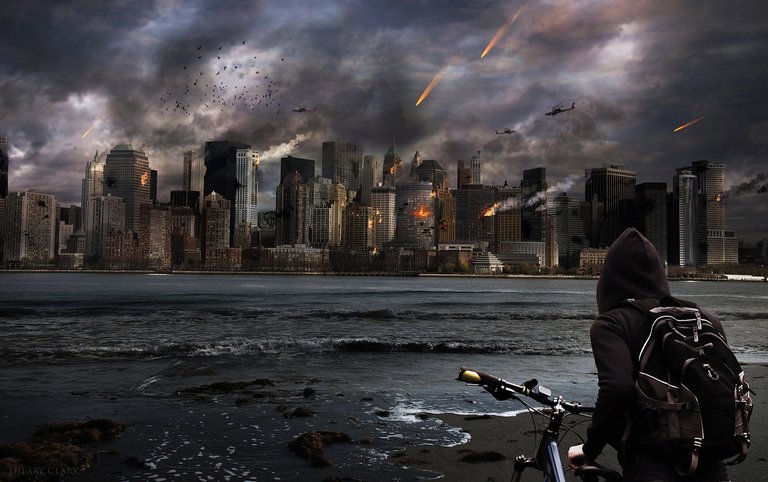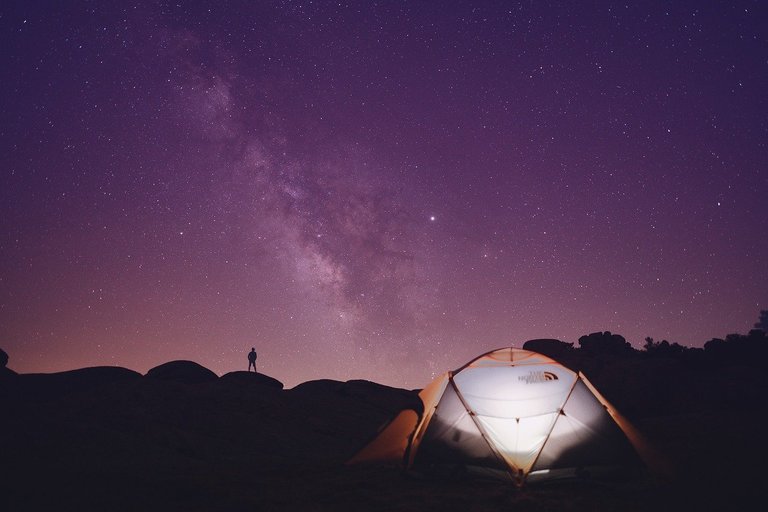A bug-out bag is your ultimate survival bag and it’s not something that you’re going to take with you on your next camping trip. A bug-out bag is something you put together for the off-hand chance that the shit hits the fan (a worldwide apocalypse perhaps) and you have to get out of dodge in a hurry.
Also known as a “72-hour bag,” a bug-out bag should have everything you need to survive for a minimum of 3 days, including shelter, a water source, medical supplies, clothing, important documents, self-defense weaponry, tools, navigational equipment, a light source, a communication device, a heat source, and anything else you can think of.
This isn’t something you should be able to put together in a few minutes or something to do while you’re sitting on the crapper and can’t reach the bottle of conditioner. It takes time, resources, commitment, and financial means to afford dependable equipment. It also requires a bit of strategic planning and intimate knowledge of the area in which you live.
Planning for the end of days
 Image by ahmadreza heidaripoor from Pixabay
Image by ahmadreza heidaripoor from Pixabay
Everybody has different needs and while no two bug-out bags are going to look alike, there will be similarities, especially if you know how to separate what you need from what you want. You don’t want to borrow one of your kid’s backpacks for this exercise either. You want something that is tactical, durable, large, and waterproof. The WintMing 70L Molle Rucksack is one of the more popular, large backpacks on the market that is relatively affordable. It’s also featured in most (if not all) of the top 5 or 10 survival backpack lists.
Getting Started
You don’t want to just go with what your mind tells you and hit up the local Walmart. You need to carefully consider step-by-step scenarios. What would cause you to leave your home, more or less immediately, along with your family (if applicable)? Anything that can force you out of your house, your castle, your one area of protection, is going to be pretty damn significant.
In a scenario like that, you have to assume that whatever the situation is, it’s not solely focused on you but is taking place on a city, state, national, or worldwide level. You also have to assume that nothing can be taken for granted. That means food, water, and shelter are luxuries that will no longer be available to you and yours.
Play devil’s advocate with yourself. Knock around a few different scenarios in your head. It’s like writing a fiction book. What would character A do if character B was accused of stealing character A’s Playstation 5? What would character A do if successfully tracking down character B resulted in the realization that character B was set up by previously unknown character C?
It sounds stupid and silly, sure, but it’s how you prepare for scenarios that have never happened to you. You are writing your own, fictional scenario in your head. What steps would you take if you have no water and the only access to water was the nearby lake? You already know the nearby lake is polluted and likely to make you and your entire family deathly ill. Water filtration device—check. Do you see how that works? It becomes scary when you think about it because it’s very difficult to gauge the moral clarity of a desperate individual—self-defense weapons, check.
- Grab a pencil and paper
- Make a list of essentials (food, water, etc.)
- Brainstorm potential scenarios
- Calculate a budget
- Bounce ideas off of family members
- Eliminate all wants
- Only include necessities
Consider the challenges of where you live
Do you live out in the boonies? If so, you will be better off in some ways and worse off in others. Do you live in the city? You will be closer to emergency services and law enforcement. However, if something happens that is so bad it drives you from your home, emergency services and law enforcement may be of no use to you, overwhelmed and otherwise occupied.
- What does the local terrain look like?
- What are some potential sources of water?
- What kind of weather does your area experience?
- Do you know anything about the local plant life?
- What kind of animals can you hunt?
- What is your assessment of potential, local threats?
- How far can you travel on foot, considering the number of family members and pets?
Obviously, Tweetie the Bird is going to have to fend for itself but a family dog might be quite useful, especially if it’s been moderately trained. The point of all of this is—the answer to the above questions will help dictate what goes in your bug-out bag and what gets left on the drawing-room floor.
If you live in a city and shit hits the fan, your number one enemy is going to be people. At least until you make your way out of the city. If you live in a more rural setting, your number one enemy is going to be nature itself and the full weight of anything planet Earth has to throw at you.
Self-Evaluation
 Image by Hemmal Abdelhakim from Pixabay
Image by Hemmal Abdelhakim from Pixabay
What kind of skills or training do you have? Were you ever in the military and, if so, do you still retain some of your training? Can you tie a tourniquet and do you know what to do in basic emergency situations? Can you start a fire without a lighter, a match, or a flare?
Whatever skills you possess, apply them to the imagined scenario of being forced from your home and out into the wilds. What tools would you need to make those skills useful? Those are things that you should write down on your checklist.
Some skills will offset the need for certain items, which will either make your bag lighter or leave room for something else that is important. If you’ve never been hiking before and have never carried more than a backpack on your back for school, you may want to keep your bug-out pack as light as possible.
You want to pack your bag for every eventuality but, the truth is, the heavier your pack is, the more painful it’s going to be on a long, overland journey. Weight consideration is very important because it could mean the difference between life and death.
Packing your bug-out bag
 Image by Hilary Clark from Pixabay
Image by Hilary Clark from Pixabay
Knowledge is power. Now that you’ve done an assessment of your own capabilities, your budget, and the local area you live in, you’re ready to start filling out your bug-out bag. Remember, keep it as light as you can. Even with a ton of hiking experience, everyone has their limitations, and extra pounds equal misery.
H2O
First and foremost, you will need a water filtration system. If society collapses, humanity will rush in on easy consumables such as water bottles and grocery store food. Even if you have water bottles handy, they will eventually run out. You’ll have to be prepared to boil and filter your water. That means packing a small pot for boiling and a container for water transportation, such as a hydration pack. You should also consider water purification tablets or iodine tablets.
Light and Heat
It might be the middle of the summer when you pack your bug-out bag but disasters don’t wait around until it’s convenient for you. You’ll need to prepare for the eventuality of winter travel and exposure to the elements. You should include a hatchet in your arsenal because it’s useful for self-defense and for chopping up kindling. A book of matches is good too, along with some paracord so you can build yourself a bow drill to start fires with as well. Paracord is also good for strapping down shelters.
You’ll need flashlights as well. You shouldn’t worry about large lanterns or anything that will take up a lot of space. Just stick with a good, dependable flashlight and make sure you have plenty of batteries as well. A headlamp would be useful and so would candles, but only if you have the space and can deal with the added weight.
Tools/Navigation
 Image by free stock photos from www.picjumbo.com from Pixabay
Image by free stock photos from www.picjumbo.com from Pixabay
This is where things get kind of fun. Sure, you’re going to pick out things that you need rather than things you want. But, the things you need are always fun to have, such as a good survival knife, some 550 paracord, or a machete.
- Survival knife and a multi-tool knife
- Hatchet
- Duct tape
- First aid kit
- Include super glue if you can’t sew wounds closed
- Zip ties
- Knife sharpener
- 550 paracord
- E-tool (basically a portable, Swiss Army trowel)
- Local area map and a larger state map
- Topographical map
- Compass
- GPS device
- Trail markers
- Flares
Topographical maps and navigational maps are two different things. While the navigational maps will help you find local roads, highways, and even some rural roads, they won’t include elevations, areas of water, and other land features. A topographical map will help you navigate the wilderness as effectively as a navigational map will help you navigate the highways.
E-tools, hatchets, some knives, GPS devices, and paracord can actually be strapped to the outside of your pack or placed in small pockets that are out of the way of food and water supplies. Duct tape and zip ties are a universal must-have because they are useful for nearly every situation. A first aid kit is a must, for obvious reasons.
Shelter and Hygiene
 Image by riya mishra from Pixabay
Image by riya mishra from Pixabay
Personal hygiene is far more important than you might think, especially early on in an emergency situation. Being filthy and not keeping your mouth clean can create all kinds of hazardous health conditions that you won’t be prepared for. An abscessed tooth is no joke, especially when there’s no one home at the orthodontist anymore.
Skin infections and bacteria become doubly dangerous in a societal collapse. There is a reason why the average lifespan of people was in the low 30s for much of ancient and medieval history. Include soap, toothbrushes, toothpaste, napkins, and washcloths.
As far as shelter is concerned, you will need a sleeping bag for certain, along with a small, lightweight tent. If you have a family with you, it’s a good idea to get a larger tent but no more than something large enough for four people.
Food/Security/Communication
Regardless of what you think about guns, you don’t want to be the person wielding a knife in the event of societal collapse. You won’t last long, especially when the first person that comes along sees that you have something he or she wants. That doesn’t mean having a knife or a hatchet with you is a bad idea but as the saying goes, “don’t bring a knife to a gunfight.”
MREs (Meals Ready to Eat) are a phenomenal source of sustenance because they are loaded with calories, which means you can afford to divide each one up a little if you’re not running solo. MREs can take up a lot of space, however, and if you have never been in the infantry, you should learn how to properly field strip an MRE so you can carry more and keep it light. When it comes to food and packing enough for three days, MREs will go a long way, probably longer than just 72 hours.
You’ll want a good, reliable compass and a GPS device. If you have read any of our articles before, you probably know that we really like Garmin and the Garmin Fenix 7 is a phenomenal GPS smartwatch. The only problem is, that charging it will be an issue if you are out in the wild so you should have a GPS device on you that will go a lot longer on the batteries it has. Fortunately, the Garmin Fenix 7 also has a solar version, so you can keep that bad boy in top shape when you’re on the trail.
A long-range radio is a good idea as well and you should really consider investing in a portable HAM radio. You have to be licensed to use it but if it’s the end of the known world, you’ll probably be fine. The reason a HAM radio would be useful is it can communicate on several frequencies other radios won’t. Plus, HAM radio enthusiasts are all about their communication devices, and if something crazy goes down, even if it’s only at a local level, you can bet there will be a lot of chatter on HAM radios.
Documentation and miscellaneous items are important as well
You’ll want to make sure that you have documentation on you no matter what. Sure, you probably keep most of the most immediately useful documents in your wallet, but probably not your permits, HAM radio license, birth certificate, social security card, financial documents, emergency contact information, etc. The cards that you don’t keep in your wallet should be kept in an ammunition case or something that is not flammable. Keep all of that right next to your bug-out bag so you can easily access them and transfer them to your bag.
Miscellaneous items are also known as “morale” items. That’s because they are the kind of things that you probably want but definitely don’t need. These are the very last items on your checklist and should only go in your pack if there is space and it won’t make the pack overly burdensome.
- Spare batteries
- Extra keys
- Salt
- Coffee
- Seasonings
- Money
- Aluminum foil
All Things Considered
Putting together a bug-out bag is all about that “just in case” scenario. So you shouldn’t make it the end all be all of your life. It doesn’t have to be put together in a single day. Take your time with it. Work some different scenarios over in your mind. Put it together based on what you think you’ll need rather than what you think you will want.
When you get the time, throw on your pack and go for an extended hike so you can get a feel for the pack and how some of the various things inside of it work for you. You’ll probably figure out some things that you will want to add and may even discover some things you don’t need.
Testing it out is how you fine-tune it and once you have that locked down, you’re prepared for any eventuality, including the end of the world. Good luck.
 Image by
Image by  Image by
Image by
Congratulations @tdgodwin3780! You have completed the following achievement on the Hive blockchain and have been rewarded with new badge(s):
Your next target is to reach 1250 upvotes.
You can view your badges on your board and compare yourself to others in the Ranking
If you no longer want to receive notifications, reply to this comment with the word
STOPCheck out the last post from @hivebuzz:
Support the HiveBuzz project. Vote for our proposal!
What about one of these, in case you encounter a zombie? 🧟♂️🤣

Lmao is that from Shield on FX? I loved that show. Yeah I thought about doing a whole section on firearms but then I figured no one would cram their AR in a bug-out bag lol